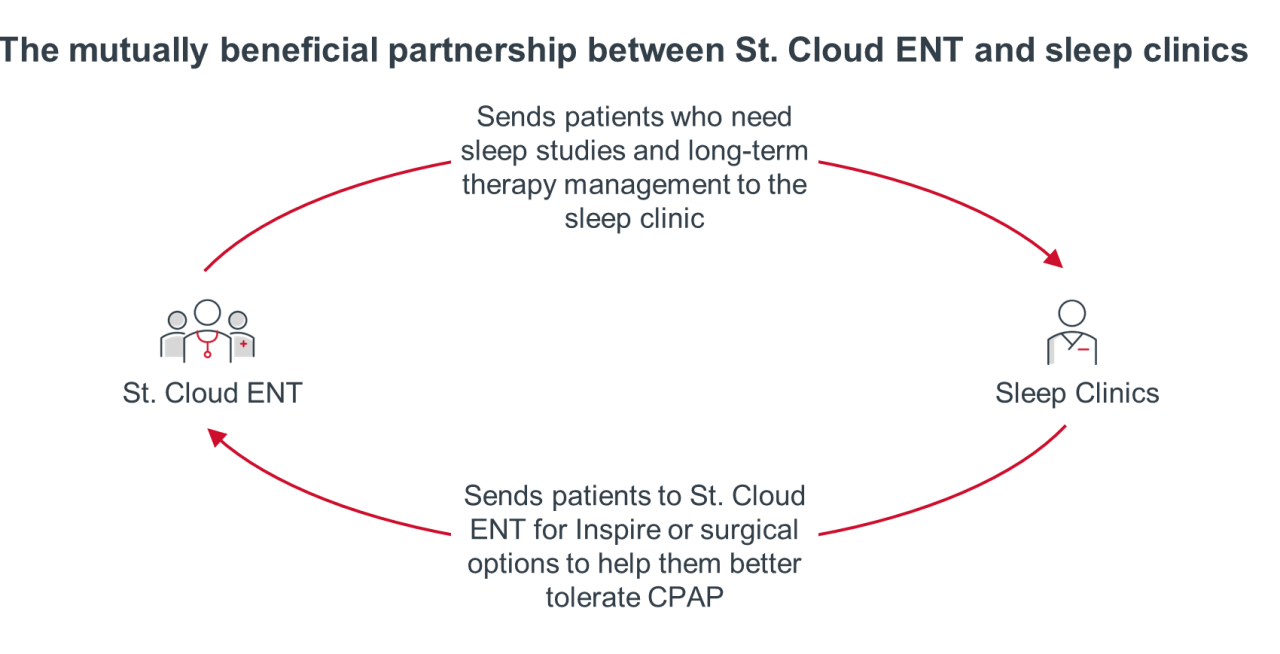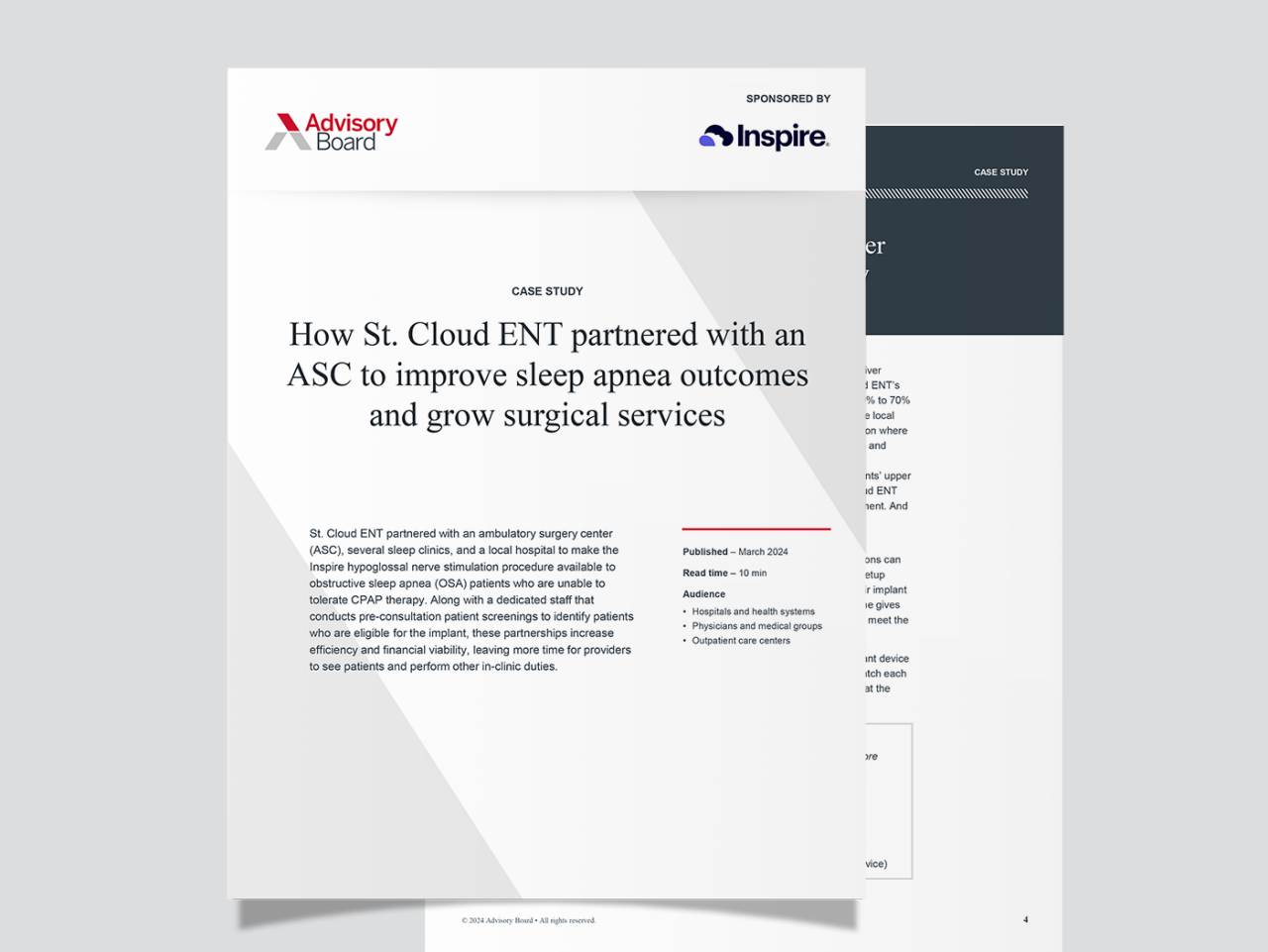Auto logout in seconds.
Continue LogoutThe challenge
Since the Inspire implant for sleep apnea became FDA-approved in 2014, healthcare organizations have worked to manage growing patient demand and refine the logistics surrounding the implant procedure.1 Providers often need to schedule more in-clinic consultations to identify eligible patients, navigate operating room (OR) scheduling and setup at different facilities, and re-route ineligible patients to alternative forms of care. As the Inspire implant draws more demand from patients suffering from sleep apnea, the need to optimize processes for the implant procedure will continue to grow.
The organization
Founded in 1966, St. Cloud ENT is a physician-owned specialty care organization that serves ear, nose, and throat patients with individualized treatment plans. St. Cloud ENT’s focus on head and neck surgery made it a strong match for the Inspire implant procedure and other surgical alternatives to treat sleep apnea.
The approach
St. Cloud ENT leaders who developed the Inspire implant program saw an opportunity to provide convenient surgical care for OSA patients who can’t tolerate CPAP therapy. By partnering with an ASC, several sleep clinics, and a local hospital, St. Cloud ENT is better able to provide timely surgical treatment for sleep apnea patients and meet the growing demand for implant surgery. Partnering with an ASC is especially fitting for the program as the implant is a quick outpatient procedure, has a very low rate of serious adverse events, and requires limited equipment. To better identify patients who are eligible for Inspire therapy, St. Cloud ENT designated a nurse to perform pre-consultation screening using biometrics, history of attempted CPAP therapy, and the results of previous sleep studies.
The result
St. Cloud ENT’s partnership with the ASC has reduced patient wait time between the initial consultation and the procedure. Implementing the pre-consultation screening process has led to a higher percentage of patients being approved for Inspire at the surgical consult. Each of these solutions leaves more time for providers to see patients and perform other in-clinic duties while improving outcomes for OSA patients and growing surgical services for the ASC.
How St. Cloud ENT partnered with an ASC to improve sleep apnea outcomes and grow surgical services
St. Cloud ENT partnered with an ASC, several sleep clinics, and a local hospital to better provide timely surgical treatment for sleep apnea patients and meet the growing demand for hypoglossal nerve stimulation. The organization also designated a nurse to perform pre-consultation screening to identify patients who are most likely to be eligible for the Inspire implant.
1. Partner with an ASC to deliver implant surgery conveniently and effectively.
For close to 60 years, St. Cloud ENT has partnered with a local ASC and hospital to deliver surgical services. Since 2014, these partnerships have boosted the success of St. Cloud ENT’s Inspire program by optimizing the implant procedure’s efficiency and flexibility. About 60% to 70% of implant procedures are performed in the ASC. The remaining implants are done at the local hospital, which can accommodate patients with more complex conditions. The decision on where to perform the procedure is influenced by factors such as the patient's medical condition and insurance coverage. By balancing Inspire implant procedures and drug-induced sleep endoscopies (DISE) — a procedure that allows providers to see which segments of patients’ upper airway are collapsing during sleep2 — between the ASC and the hospital setting, St. Cloud ENT can use resources more efficiently, such as available operating rooms, staff, and equipment. And using resources more efficiently gives both providers and patients more flexibility when scheduling procedures.
The ASC can shorten the wait time for the implant procedure for the right patient. Surgeons can often do multiple procedures back-to-back in the ASC, and consistent staffing and OR setup contribute to reduced turnaround times between procedures so patients can receive their implant and begin the healing process sooner. Doing more procedures within a shorter timeframe gives providers more time to see patients and perform other in-clinic duties, which helps them meet the growing demand for surgical sleep apnea care.
Both the hospital and ASC settings manage overhead costs effectively. For ASCs, implant device inventory must be carefully managed, so the ASC coordinates with St. Cloud ENT to match each device with a patient before ordering. Providers at St. Cloud ENT aim to do procedures at the most cost-effective site that is best suited for the patient’s needs.
Checklist for partnership with an ASC St. Cloud ENT ensured the ASC had the right processes and equipment in place before approaching them to become partners.
|
2. Collaborate with sleep medicine specialists to find patients who can’t tolerate CPAP therapy.
CPAP therapy, the first-line treatment for obstructive sleep apnea, doesn’t work for everyone. Patients who can’t tolerate CPAP therapy may stop using their CPAP machine, or only use it intermittently, without following up with a provider. Allowing these patients to fall through the cracks has far-reaching effects for patients and healthcare systems.
A unique collaborative relationship between St. Cloud ENT and area sleep clinics makes the Inspire implant program easier to implement and keeps it sustainable. St. Cloud ENT works closely with sleep specialists to find solutions for sleep apnea patients who can’t use their CPAP machine regularly or have stopped using it altogether. In addition to Inspire therapy, St. Cloud ENT offers surgical services that may help patients better tolerate CPAP therapy or become eligible for the Inspire implant, such as addressing nasal obstruction and palatal issues. Because St. Cloud ENT only offers Inspire implants to patients who cannot tolerate CPAP therapy, sleep clinics are not in competition to manage their sleep apnea patients. Instead, they play a critical role in the success of the Inspire implant program. After the implant procedure, patients return to the sleep clinic for post-implant management and long-term follow-up.
Thanks to this collaborative approach, patients who may have otherwise fallen through the cracks have another avenue to alleviate their sleep apnea. Sleep clinics refer patients who can’t tolerate CPAP to St. Cloud ENT for consultation, and St. Cloud ENT refers patients back to the sleep clinics to manage sleep disorders nonsurgically. On average, patients who received the implant reduced their apnea-hypopnea index (AHI) scores from 32 events per night to less than six.

3. Increase awareness to attract patients and coordinate care to retain them.
The Inspire implant procedure is in high demand, and a large percentage of consults are driven by advertising, social media marketing, and word-of-mouth recommendations. Due to that large influx of potential implant patients, St. Cloud ENT has shifted focus to efficiently identifying eligible implant patients and improving care coordination to route all patients to the right care. Before a patient schedules a consultation, a nurse screens them for body mass index (BMI), whether they can tolerate CPAP treatment, and whether they’ve had a sleep study done recently. If the patient meets the eligibility criteria, they schedule a consult. After implementing the screening process, 60% to 70% of patients who scheduled a consult at St. Cloud ENT qualified for the procedure — up from less than 50% before the screening process was implemented.
Percentage of patients who schedule a consult and qualify for the implant procedure
St. Cloud ENT also works closely with primary care providers (PCPs) and specialists treating common comorbidities seen in OSA to connect patients who aren’t eligible for Inspire to other forms of care. For example, sleep clinics refer patients who need surgical procedures for conditions that prevent patients from tolerating CPAP therapy, such as structural issues with the nasal septum or nasal polyps, to St. Cloud ENT.
By establishing effective care coordination channels with PCPs and other specialists, St. Cloud ENT created a system to redirect ineligible patients to providers who can help them address comorbid conditions, reconsider other sleep apnea solutions, or modify their lifestyle to help them qualify for Inspire in the future. Although they are not eligible for the Inspire implant, these sleep apnea patients remain engaged with the health system.
St. Cloud ENT’s initial screening checklist3
|
How we know it’s working
The partnership between St. Cloud ENT and the ASC has allowed the Inspire program to become one of the longest-running Inspire implant programs in the country.
Average annual growth rate since program initiation
Implants performed across ASC and hospital settings
Years of consistent and sustained success with the ASC
Patient satisfaction is very high — there are many success stories. New patients often find us through word-of-mouth from others who’ve had the procedure done or referring physicians who have seen a lot of happy patients coming back to see them.
Inspire Medical Systems, Inc., is a medical innovation company committed to the safe, effective, and reliable treatment of obstructive sleep apnea in order to improve patient lives.
Inspire® therapy is a solution for people with obstructive sleep apnea who have tried and struggled with CPAP. The Inspire® implant works inside the body to treat the root cause of OSA, enabling patients to breathe regularly and sleep soundly. Learn more at inspiresleep.com.
This report is sponsored by Inspire, an Advisory Board member organization. Representatives of Inspire helped select the topics and issues addressed. Advisory Board experts wrote the report, maintained final editorial approval, and conducted the underlying research independently and objectively. Advisory Board does not endorse any company, organization, product or brand mentioned herein.
To learn more, view our editorial guidelines.
1 Note: Unless otherwise specified, all information in this case study came from Advisory Board interviews with officials from St. Cloud ENT and St. Cloud Surgical Center.
2 Carrasco-Llatas, M, Matarredona-Quiles, S, De Vito, A, et al. Drug-Induced Sleep Endoscopy: Technique, Indications, Tips and Pitfalls. Healthcare. July 24, 2019.
3 St. Cloud ENT’s pre-consultation screenings include criteria that go beyond the FDA indicators for the Inspire procedure. Other FDA indicators are evaluated with further testing and during the surgical consultation.
4 Apnea-hypopnea index.

This report is sponsored by Inspire. Advisory Board experts wrote the report, maintained final editorial approval, and conducted the underlying research independently and objectively.
Don't miss out on the latest Advisory Board insights
Create your free account to access 1 resource, including the latest research and webinars.
Want access without creating an account?
You have 1 free members-only resource remaining this month.
1 free members-only resources remaining
1 free members-only resources remaining
You've reached your limit of free insights
Become a member to access all of Advisory Board's resources, events, and experts
Never miss out on the latest innovative health care content tailored to you.
Benefits include:
You've reached your limit of free insights
Become a member to access all of Advisory Board's resources, events, and experts
Never miss out on the latest innovative health care content tailored to you.
Benefits include:
This content is available through your Curated Research partnership with Advisory Board. Click on ‘view this resource’ to read the full piece
Email ask@advisory.com to learn more
Click on ‘Become a Member’ to learn about the benefits of a Full-Access partnership with Advisory Board
Never miss out on the latest innovative health care content tailored to you.
Benefits Include:
This is for members only. Learn more.
Click on ‘Become a Member’ to learn about the benefits of a Full-Access partnership with Advisory Board
Never miss out on the latest innovative health care content tailored to you.



